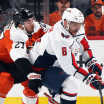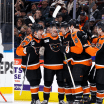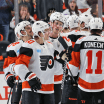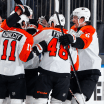5 THINGS: Flyers @ Rangers
Alain Vigneault's Philadelphia Flyers (8-8-4) are in Manhattan on Wednesday to take on Gerard Gallant's New York Rangers (13-4-3).
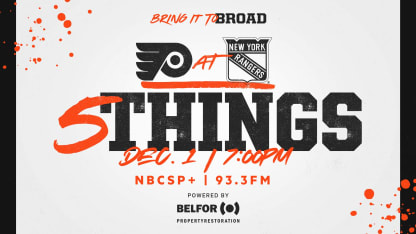
This is the first of four meetings this season between the traditional arch-rival clubs. The clubs will clash again on Jan.15 at the Wells Fargo Center in Philadelphia, April 3 in New York and April 13 in Philadelphia.
Last season's eight game season series between the clubs progressed in a bizarre fashion. The Flyers went 4-3-1 against the Rangers overall but the season included a 9-0 humiliation at MSG on March 17 that was followed by an 8-3 drubbing at the Rangers' hands in Philadelphia just six nights later. The Flyers then won each of the next two meetings before New York won the finale.
Heading into this game, which will open a 13-game slate (eight road, five home) for the Flyers in December, Philadelphia will look to put an end to a six-game winless streak. The Rangers have points in eight of their last 10 (7-2-1).
The Flyers are 2-6-2 over their last 10 games, falling to "hockey .500" on the season after posting a 7-3-2 record through the first 12 games. The Rangers surge in the last 10 games has propelled them at the quarter pole of the 2021-22 season into what would be automatic playoff position on the Metro Division if the campaign ended today.
Here are five things to track in Wednesday's game:
1. Hayesy Days are Here Again?
Due to a pair of abdominal muscle tear repair surgeries during the 2021 calendar year and a subsequent physical setback, Flyers center Kevin Hayes (1g, 1a) has been limited to two games played this season. On Tuesday, he was a full participant at the Flyers practice at the FTC in Voorhees. Afterwards, Flyers general manager and president of hockey operations Chuck Fletcher said that Hayes should be ready to go for this game but that the final determination will be made based on how Hayes feels on Wednesday morning.
"He really wants to play. He's made tremendous progress the last week. He told me yesterday this is the best he's felt in over a year. It's real positive," Fletcher said.
Getting Hayes back in the lineup is only half of the equation for the Flyers. The other half will be for to stay healthy enough to remain in the lineup and for him to work his way into playing effectively. Hayes had a strong first season as a Flyer in 2019-20 and was a big factor in the team's surge that year. Significantly hampered a season ago by what turned out to be a core muscle tear, Hayes had a rough 2020-21 season along with the entire Flyers team. Having not had a training camp or preseason this fall, and having only been able to dress in two regular season games to date, it's going to take time for the player to work his way into form even if he can avoid further physical setbacks.
The Flyers remain without Derick Brassard (hip injury) in the lineup. Brassard practiced with the team on Tuesday but felt discomfort while he skated. He officially remains day-to-day but is unlikely to play imminently. Playmaking rookie center Morgan Frost, who collected his first assist of the NHL season last Friday against Carolina and who set up three separate prime scoring chances (with no points resulting) in Sunday's game against the Devils, centered a remade fourth line at Tuesday's practice. However, with Brassard still dealing with the hip issue, Frost will center a line on Wednesday with team captain Claude Giroux and right winger Cam Atkinson.
Joel Farabee, who has scored three goals over the last three games, has been moved up to the top line centered by the recently struggling Sean Couturier. Farabee had been with Atkinson and Frost for the majority of the three previous games. The Flyers, who have been in a nightmarish 5-for-54 spell on the power play that has seen personnel and alignments shuffled multiple times with little to show in terms of progress in generating entries and puck movement (let alone goals), also reshuffled the deck on the power play units at Tuesday's practice.
Scott Laughton stepped up for the Flyers in Sunday's game in New Jersey. He scored a first period shorthanded goal and then set up Farabee in the third period as the Flyers battled back from deficits of 1-0 and 2-1. Unfortunately, the Flyers went on to cough up two additional goals at even strength and then an empty-netter after Philly had initially seemed to have momentum in their favor after getting the score to 2-2.
Carter Hart will get the start in goal for the Flyers on Wednesday. He had a rough afternoon (primarily in the second period) in the Black Friday debacle against the Hurricanes but it was primarily due to very poor play by the team in front of him: getting screened by his own defenseman, several large-scale breakdowns on coverages including a blown weak-side assignment, a trailer on an earlier rush, a deflected puck and one goal where Hart was off-angle a bit. Overall, Hart is still having a strong season thus far. The projected starting lineup:
86 Joel Farabee - 14 Sean Couturier - 25 James van Riemsdyk
28 Claude Giroux - 48 Morgan Frost - 89 Cam Atkinson
21 Scott Laughton - 13 Kevin Hayes - 11 Travis Konecny
23 Oskar Lindblom or 71 Max Willman - 82 Connor Bunnaman - 17 Zack MacEwen
9 Ivan Provorov - 24 Nick Seeler
6 Travis Sanheim - 70 Rasmus Ristolainen
3 Keith Yandle - 61 Justin Braun
79 Carter Hart
[35 Martin Jones]
On the power play, there were a lot of moving parts at Tuesday's practice.
1st unit: Giroux (right side), Hayes (left side), Atkinson (slot), Frost (netfront), Yandle (point).
2nd unit: Couturier (left side), Farabee (right side), Konecny (slot), JVR (netfront), Provorov (point).
2. Will Flyers reset the process?
The underlying transition game and offensive processes that lead to scoring goals or at least generating Grade A chances -- clean breakouts, speed through the neutral zone, establishing a forecheck -- have been out of whack for the Flyers for too much of the season to date. Defensively, the keys to enabling a team's goaltenders to have a maximum chance at saves -- clean looks at pucks, good gap control, attention to detail on coverage assignments, etc -- started out fine in October but have gone increasingly awry over the last 10 games.
Overall, the team, quite simply, has had to defend too much because it lacks sustained or quality puck possession. Competitiveness-wise (battling for pucks and space, blocking shots, etc) and in terms of physicality, the Flyers ARE improved from what was on display last year despite what some recently have said to the contrary. These improvements have also manifested on the penalty kill, where Philly has shown noticeable improvement after a horrendous season in that department in 2020-21.
Over the first 12 games this season, the Flyers puck-possession and puck-management deficits were largely confined to second periods. The team tended to get off to good starts in the first period. They also tended to win third periods or at least more or less hold even. It was in second periods where Philly would get caved in and spend most of the 20 minutes relying on their goalies to almost singlehandedly keep the score under control. That pattern was not ideal for the long haul but at least was manageable in the short term.
Over the last eight games in particular, the problems have no longer been primarily a second-period issue. There have been nearly entire games where the underlying processes of winning puck battles and generating positive shifts have been substandard. In other words, rather than cleaning up the trouble spots, the issues have gotten worse. The team is now in back-to-the-drawing board mode.
On Tuesday, Fletcher hinted at some adjustments the coaching staff has discussed. The specifics remain to be seen.
The ongoing absence of top-pairing defenseman Ryan Ellis has had a major negative impact on breakouts and generating quality shots in the offensive zone. There are. however, some steps that teams in similar situations to the current Flyers have employed effectively to slow down opponents.
For example, early in the second quarter of the 2017-18 season, the Flyers were in a scoring funk with an ailing O-zone forecheck. They also saw deterioration of their neutral zone management and were spending too much time defending. During a western Canada road trip in December 2018, the team markedly changed the forecheck to drop it back into an old-school looking 1-2-2 (AKA neutral zone trap).
It wasn't thrilling hockey to watch but it worked to stop the bleeding.
During the Alain Vigneault regime, the Flyers have tended to rely heavily on a two-man offensive zon forecheck; the first forechecker ("F1") applies pressure and the second ("F2") goes for the puck. To be executed effectively, it's vital to play with good pace. When done properly, it works well. If not, it's too easy to beat the forecheck with a single good pass.
The Flyers forecheck worked very well for much of the 2019-20 season and also was humming along nicely -- at least in first periods of games -- early this season. Of late, though, opponents have had little trouble beating the Philly forecheck. With Ellis still unavailable to help springboard the attack with pace, the Flyers might need to make a similar adjustment to what the club did effectively (with a lesser on-paper roster) about this time four years ago.
3. Inside the Numbers.
The Rangers have been winning a healthy percentage of games this season, especially of late. Overall, though, they've done so in ways that defy the current analytics-driven models that predict which teams will and won't have sustained success.
New York ranks 31st in the NHL in terms of shot attempt differentials at five-on-five (Corsi) and sixth from the bottom in so-called "expected goal" stats (a measure of shot quality based on the area of the ice from where pucks are shot). The Rangers, however, are slightly above water in terms of their actual 5-on-5 goal differential (37 GF/ 35 GA) and their power play is north of 20 percent (20.3 percent) for the season.
Although outshot by opponents on average across all three periods, the Rangers are in the black in goal differentials across 1st (12-11), 2nd (22-18) and 3rd (24-22) periods. A big part of the season has been the play in goal by Igor Sheshterkin. The Russian netminder brings an 11-3-2 record, 2.22 GAA, .933 save percentage and one shutout into this game.
Flyers vs. Rangers: Goal and shot differentials by period, special teams, goals by situation.
— Bill Meltzer (@billmeltzer) December 1, 2021
Also of note: NYR rank last in the NHL in Corsi share (Flyers 3rd from bottom) and 6th worst in xGF% (Flyers 3rd from bottom). But NYR is +6 in goal differential and Flyers are -10. pic.twitter.com/aogUHrxpH2
For the Flyers, the club won a lot of early season games with strong first periods and/or third period surges. The third period numbers, however, have since dropped under water. Second periods still remain the No. 1 problem with a minus-12 goal differential (14 GF/ 26 GA) and unacceptable 255 to 184 shots on goal differential.
4. Behind Enemy Lines: New York Rangers
There is no secret as to what the Rangers want to do every game: get the puck as much as possible onto the stick of Artemi Panarin (21 points including 16 assists) and have Adam Fox trigger the rush from the back end and join the attack up ice as much as possible (21 points including four goals).
Fox torched the Flyers last season in particular, racking up 10 assists in seven games. Meanwhile, games against the Flyers almost singlehandedly rescued Mika Zibanejad's 2020-21 campaign after he struggled massively at the start. In eight games against the Flyers last year, Zibanejad shredded them for seven goals and 18 points.
Chris Kreider also collected a hat trick in a game against the Flyers last season on the way to four goals in the season series against Philly. Panarin, who feasts off most every NHL opponent, had 10 points (3g, 7a) in seven appearances against the Flyers last season.
Ryan Strome has 14 points (3g, 11a) across 16 games played to date this season. Last season, he had 10 points in eight games (1g, 9a) against the Flyers.
Thus far in his young career, 20-year-old Alexis Lafreniere has struggled to meet the "can't-miss superstar" hype that accompanied him into being the first overall pick of the 2020 NHL Entry Draft. That said, for most players his age, starting off a career with 17 goals and 27 points in 76 games (including five goals in this season's first 20 games) would be considered a fine start to a career.
Now in his third pro season, 2019 second overall pick Kaapo Kakko, also struggled to meet expectations of immediate NHL superstardom. Has he started to turn the corner? Time will tell.
Kakko recently had a five-game point streak (3g, 3a) before being held off the board in the last game. He is skating on Zibanejad's line. However, he dealt with an early-season injury and was pointless in his first 10 games. At the very least, Kakko has recently been on a hot streak.
Projected lineup:
20 Chris Kreider - 93 Mika Zibanejad - 24 Kaapo Kakko
10 Artemi Panarin - 16 Ryan Strome - 29 Dryden Hunt
13 Alexis Lafreniere - 72 Filip Chytil - 15 Julien Gauthier
17 Kevin Rooney - 21 Barclay Goodrow - 75 Ryan Reaves
55 Ryan Lindgren - 23 Adam Fox
79 K'Andre Miller - 8 Jacob Trouba
12 Patrik Nemeth - 27 Nils Lundkvist
31 Igor Sheshterk
[40 Alexandar Georgiev]
PP1: Zibanejad, Kreider, Strome, Panarin, Fox.
PP2: Lafreniere, Chytil, Kakko, Trouba Lundkvist.
5. Players to Watch: Provorov and Trouba
Especially given the absence of projected defense partner Ellis in 16 of the season's first 20 games, the Flyers place a huge reliance on Ivan Provorov to be the backbone of the defense corps.
In October, Provorov was only on the ice for one opposing five-on-five goal. He was a traditional plus-six across the first seven games (paired with Ellis in the first three) despite posting only one point.
In November, Provorov had seven points in 13 games (2g, 5a) but once partner Justin Braun and Provorov, especially the latter, hit a wall in their play, it's been a struggle. Provorov was a traditional minus-seven in his November games and is minus-six across the last six games.
This, of course, is a major over-simplification of the team's issues as well as the downturn in his individual play. However, the bottom line is that the Flyers need a lot better from Provorov than he showed at key junctures of several recent losses.
Beyond Provorov, the Flyers need their other top players, starting with Sean Couturier, to start stepping up again. This would be the simplest route to righting the ship. They've actually started to get a little scoring again lately from a few secondary sources -- Brassard's two-goal game against Boston prior to his recent injury, Laughton's step-up game against the Devils this last Sunday. But more is needed from a wider array of players, and it has to start at the top.
For the Rangers, the team initially had to miscast Trouba as their top-of-blueline catalyst upon his arrival from Winnipeg in 2019. He'll never be an elite point-producer. Rather, he's a rock-steady two-way defenseman who eats a lot of all-situation minutes and can also chip in offensively (3g, 5a, 22:38 TOI despite starting less than 45 percent of his 5-on-5 shifts in the offensive zone). That's his sweet spot in terms of ideal usage.
The Rangers have built a formidable top four on defense, and Trouba remains a vital part of that balance even though Fox nowadays draws most of the accolades as its marquee star.





